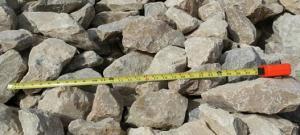
Crushed Limestone Rock versus Crushed Concrete Rock
As a result of the number of questions that we at Select Sand & Gravel receive regarding the usage of Crushed Limestone Rock versus Crushed Concrete Rock, we felt it was important to state the differences in these types of Rock. There is an abundance of both materials in Dallas, Fort Worth, Austin, San Antonio, and Houston Texas markets that our company serves. We thought it would be prudent to write an article to provide an overview as to the pros and cons of each type: Crushed Limestone Rock and Crushed Concrete Rock.
Both of these Aggregate Rock materials are used in the formulation of concrete as well as other applications. As such, a quick explanation of concrete would also be useful. Concrete was originally formulated by the ancient Romans. Generally speaking, it is poured into a mold when in the liquid form. Over the course of time it hardens into a formidable surface. Concrete is a mixture of cement, sand, and crushed rock or stone of different varieties. In the Texas area most of the crushed rock that is utilized is crushed limestone, crushed concrete, or a smooth river rock. The hardness of the stone is very important as there is a correlation between stone hardness and strength of the finished concrete.
There are other uses for Crushed Limestone. Specifically, Crushed Limestone can be used as Road Base, Construction Entrance Rock, Pipe Embedment (Pipe Bedding), Rip Rap (Erosion Control), Under a construction slab, Driveway Gravel, or as a Roofing Gravel surface. Crushed Concrete can be interchanged to be used for some of the same applications with consideration of hardness and the appropriate engineering factors. 
In order to provide clarification of the Crushed Limestone Rock material, we will attempt to define Limestone itself. Limestone is a naturally occurring stone that is found in abundance throughout much of the United States. It is a sedimentary rock, composed mainly of skeletal fragments of marine organisms such as coral, forams and molluscs. The major materials in Limestone are the minerals calcite and aragonite, which are different crystal forms of calcium carbonate. Limestone itself has numerous uses: as a building material, an essential component of concrete (Portland cement), as aggregate for the base of roads, as white pigment or filler in products such as toothpaste or paints as well as other uses. (Ref. https://en.wikipedia.org/wiki/Limestone and http://www.worldofstones.com/blog/limestone/)
Crushed concrete is as it’s name sounds. It is aging concrete that has been recycled, crushed, and reused in the construction industry. Often times, aging structures (sidewalks, road surfaces, foundation slabs) are removed for various reasons. When these old concrete structures are demolished in large urban areas, (such as Dallas, Fort Worth, Austin, San Antonio, or the Houston Texas areas), they are transported to a Concrete Recycling Company. These Concrete Recycling Companies will crush the old concrete into various sizes of Crushed Concrete Rock for differing applications. Some of the material is crushed to be used as road base, construction entrance rock, or driveway gravel. Some of the concrete is crushed into small concrete rock for utility (pipe bedding) applications and drainage (landscape) applications. In addition, some of the concrete is crushed into larger concrete rock for construction entrances and erosion control applications (Rip Rap, Gabion Crushed Rock material). It is important to note that because the concrete material is recycled into Crushed Rock it may not be aesthetically pleasing. However, it can be used very effectively for the right project.
We at Select Sand & gravel recognize that both Crushed Limestone Rock and Crushed Concrete Rock have useful Commercial, Industrial and Residential applications. In most cases the rock products can be used interchangeably. Crushed Limestone Rock tends to be more visually pleasing. Crushed Concrete Rock tends to be less expensive.
Over time, many of the Crushed Limestone Rock Quarries have progressively moved away from the cities due to materials being exhausted and urban sprawl. The Crushed Concrete Rock however, is able to be produced in most cases right in the middle of town which can provide the material less expensively for construction or residential project uses. We at Select Sand & Gravel are a supplier of Crushed Limestone Rock and Crushed Concrete Rock for the uses stated above (Rip Rap, Road Base, Gabion, Pipe Bedding, and other project usages).
Contact us at our office numbers if we can assist with further clarification regarding Crushed Limestone Rock or Crushed Concrete Rock and/or with any Sand or Gravel deliveries. Additional product information may be found by accessing this LINK.